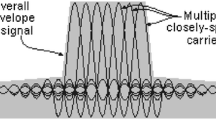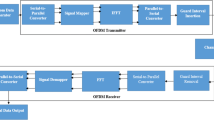Abstract
One of the major drawbacks of multicarrier modulation is the large envelope fluctuations which either require an inefficient use of high power amplifiers or decrease the system performance. Peak-to-average power ratio (PAPR) is a very well known measure of the envelope fluctuations and has become the cost function used to evaluate and design multicarrier systems. Several PAPR-reducing techniques have been proposed with the aim to alleviate back-off specifications or increase the system performance. Besides the fact that these techniques have varying PAPR-reduction capabilities, power, bandwidth and complexity requirements, it is interesting to notice that the performance of a system employing these techniques has not been fully analyzed. In this paper we, first, develop a theoretical framework for both PAPR and the distortion introduced by a nonlinearity, and then simulate an OFDM system employing several well known PAPR-reducing techniques from the literature. By means of the theoretical analysis and the simulation results we will show the relation between PAPR and the performance of OFDM systems when a clipping device is present and we will evaluate the real performance improvement capabilities of the PAPR-reducing methods. The agreement between the theoretical and the simulation results demonstrate the validity of the analysis.
Similar content being viewed by others
References
Han S.H., Lee J.H. (2005). An overview of peak-to-average power ratio reduction techniques for multicarrier transmission. IEEE Wireless Communications Magazine, 12, 56–65
van Nee, R., & Prasad, R. (2000). OFDM for wireless multimedia communications. Artech House.
Katz A. (2001). Linearization: reducing distortion in power amplifiers. IEEE Microwave Magazine, 2 (4): 37–49
Bussgang, J. (1952). Crosscorrelation function of amplitude-distorted Gaussian signals. Research laboratory of electronics, Massachusetts Institute of Technology, Cambridge. Technical Report 216.
Dardari D., Tralli V., Vaccari A. (2000). A theoretical characterization of nonlinear distortion effects in OFDM systems. IEEE Transactions on Communications, 48, 1755–1764
Krongold B.S., Jones D.L. (2003). PAR reduction in OFDM via active constellation extension. IEEE Transactions on Broadcasting, 49(3): 258–268
Tellado, J., & Cioffi, J. (1998). Efficient algorithms for reducing PAR in multicarrier systems. In Proceedings of IEEE International Symposium on Information Theory, p. 191.
Ciminim Jr. L.J., Sollenberger N.R. (2000). Peak-to-average power ratio reduction of an OFDM signal using partial transmit sequences. IEEE Communication Letters, 4, 86–88
Bäuml R.W., Ficher R.F.H., Huber J.B. (1996). Reducing the peak-to-average power ratio of multicarrier modulation by selected mapping. IEE Electronic Letters, 32, 2056–2057
Deumal, M., Behravan, A., Eriksson, T., & Pijoan, J. L. (2007). Constrained clipping for Peak Power reduction of multicarrier systems by Tone Reservation. In Proceedings of IEEE Vehicular Technology Conference Spring, pp. 2195–2199.
3GPP TSG RAN WG4 #31, 3GPP TSG RAN WG1 #37. Comparison of PAR and Cubic Metric for power de-rating. Motorola Tdoc R4-040367, R1-040522 and R1-040642, May 2004.
3GPP TSG RAN WG1 LTE. Cubic Metric in 3GPP-LTE. Motorola Tdoc R1-060023, Jan. 2006.
Behravan A., Eriksson T. (2006). Some statistical properties of multicarrier signals and related measures. In Proceedings of IEEE Vehicular Technology Conference Spring, 4, 1854–1858
Author information
Authors and Affiliations
Corresponding author
Rights and permissions
About this article
Cite this article
Deumal, M., Behravan, A., Eriksson, T. et al. Evaluation of Performance Improvement Capabilities of PAPR-reducing Methods. Wireless Pers Commun 47, 137–147 (2008). https://doi.org/10.1007/s11277-007-9397-6
Accepted:
Published:
Issue Date:
DOI: https://doi.org/10.1007/s11277-007-9397-6




